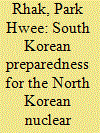| Srl | Item |
| 1 |
ID:
160351


|
|
|
|
|
| Summary/Abstract |
The ROK–China conflicts due to the THAAD deployment in South Korea and
the Trump administration’s preemptive strike doctrine toward the DPRK have put
the security of the Korean Peninsula in a grave state. At the same time, positive
expectations for ROK–DPRK–U.S. talks have been growing recently. However,
since whether the United States will conduct a preemptive strike or not depends
on the results of the U.S.–DPRK talks, the security of the Korean Peninsula is in a
precarious state.
This paper, therefore, attempts to analyze the Sino–North Korean Mutual Aid
and Cooperation Friendship Treaty (hereafter referred to as the Sino–North
Korean Friendship Treaty) that will allow for the reconsideration of China’s role
in nullifying the uncertainty on the Korean Peninsula according to the treaty. The
Automatic intervention, according to Article 2 of the Sino–North Korean Friendship
Treaty, is an exercise of the right of self-defense that can be implemented when the
requirements of necessity and proportionality of Customary International Law are
met, and only until the UN Security council takes appropriate measures, according
to Article 51 of the UN Charter. China’s intervention in the case of contingency on
the Korean Peninsula, according to the Sino–North Korean Friendship Treaty, has
limitations with regards to compliance with Articles 48 and 103 of the UN Charter.
It is a special treaty based on the historical background between North Korea and
China. Also, since China recently adopted “non-alignment” as a foreign policy, it
is unlikely that the
|
|
|
|
|
|
|
|
|
|
|
|
|
|
|
|
| 2 |
ID:
153509


|
|
|
|
|
| Summary/Abstract |
This paper reviews the current state of South Korean nuclear preparedness and
draws out some necessary tasks for the future. It reviews all available options that a
non-nuclear, threatened country should take in response to the level of the nuclear
threat. These are a diplomatic approach, a preventive strike, deterrence, defense,
civil defense, and negotiations. In conclusion, South Korea has depended too much
on diplomatic solutions in the initial periods of the North Korean nuclear weapons
development. It did not review defense measures in depth and did not consider
the preventive strike option during that period. South Korea procrastinated on its
Ballistic Missile Defense (BMD) construction and did not review the necessity of
nuclear civil defense until the present. South Korean nuclear preparedness appears
to have many shortcomings. South Korea should expedite and improve its BMD
shield as soon as possible. It may need to utilize the preemptive strike capabilities of
the United States to provide more money for its BMD. It needs to prepare nuclear
blast and/or fall-out shelters by efficiently renovating existing conventional shelters
and other underground facilities.
|
|
|
|
|
|
|
|
|
|
|
|
|
|
|
|
| 3 |
ID:
107696


|
|
|
|
|
| Publication |
2011.
|
| Summary/Abstract |
The purpose of this article is to decide whether a preemptive strike is a better option for a weaker power at the beginning of an asymmetric military conflict. The author examines five possible situations in the Taiwan Strait crisis via normal form game, extensive form game, and mixed strategy in order to discover why a weaker power might choose to launch a preemptive strike under certain circumstances. The findings show that no matter whether two or three countries are involved in armed conflict in the Strait or whether such an asymmetric conflict is initiated by Taiwan or China, it would always be in Thiwan's interest to assert preemption, assuming conflict has become inevitable. Given situations of incomplete information, the results still hold. This presents strong evidence that a weaker power facing unavoidable armed conflict should strike first. This study also proves that the threat need not be "imminent": it need only be "inevitable."
|
|
|
|
|
|
|
|
|
|
|
|
|
|
|
|